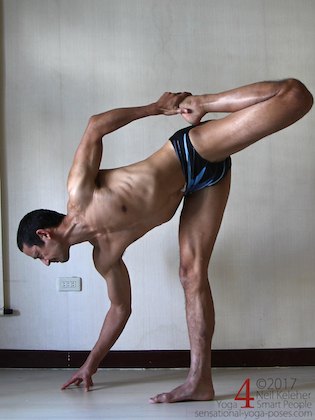Three Reasons Why You Should Improve Flexibility
One is that it can help you learn your body
There's a growing trend to use science to say why you should or shouldn't do something, for example, getting more flexible. (and here I'll define flexibility as being able to control your muscles through a wide range of motion). Instead of science I'm going to resort to common sense.
The First Common Sense Reason for Improving Flexibility
One reason for improving flexibility is simply because you want to. If you want to be able to touch your toes or reach beyond them then obviously you have to improve hamstring flexibility so that you can do that. There is nothing wrong with wanting to get more flexible simply for the sake of it. (And it is really cool to reach goals like touching your butt to the floor in virasana, or getting the front splits, or more challenging yet, side splits).
Flexibility Means you Can Do More Things
Another reason for improving flexibility is that it allows you to do more things. If you are into martial arts or dancing, better leg flexibility allows you to kick or move your legs higher. (Better control is also an important part of that.) Improving hamstring flexibility to the point that you can touch your hands easily to the floor means that you can then work towards moving into a handstand from a standing forward bend. It means you can tie your shoelaces without having to bend your knees.
Improving Flexibility Requires Understanding
Yet another reason for improving flexibility, and this ties in a little with the first two, is that it is a good way to get to know your body.
Improving flexibility comes from understanding how your body works, or learning how it works so that you can control it in the right way to allow you to move towards whatever stretch that it is that you are doing.
Solving the Problem of Inflexibility
A lack of flexibility could be viewed as a problem, particularly if it means you can't do what you want to do. And like with any problem, the solution comes from understanding what you are working with, in this case, your body.
The better your understand your body particularly how joints and muscles work, the easier (and more likely) it is that your flexibility can be improved.
And even if you don't yet understand your body, the process of getting more flexible can be a part of how you learn your body.
Expanding the Experience of Your Own Body
The task of improving flexibility can then become an interesting and even joyous task because your are learning your body and in the process experiencing it, which is actually one way of defining what yoga is.
Yoga is the direct experience of what is happening now.
So instead of just trying to get the splits, and being frustrated when you don't get them (at least not straight away), each time you try a different selection of warm up poses, each time you try a different selection of muscle activations you are expanding your experience of your own body.
Do You Want to Do Just One Thing?
Will flexibility lead to better running? Maybe, maybe not. But if you do more than just run, (or want to) then better flexibility may allow you to do other things well as well as running. And in a way that might be the best way to think about flexibility. It doesn't necessarily allow you to do one thing well. It allows you to do lots of different things.
So if you are wondering whether or not you should work on improving your flexibility, ask yourself this question. Do you want to do one thing or many different things? And if you want to do one thing, do any of its actions require greater flexibility.
If so, then get working on improving your flexibility now.
Published: 2017 10 27
Updated: 2021 01 29



